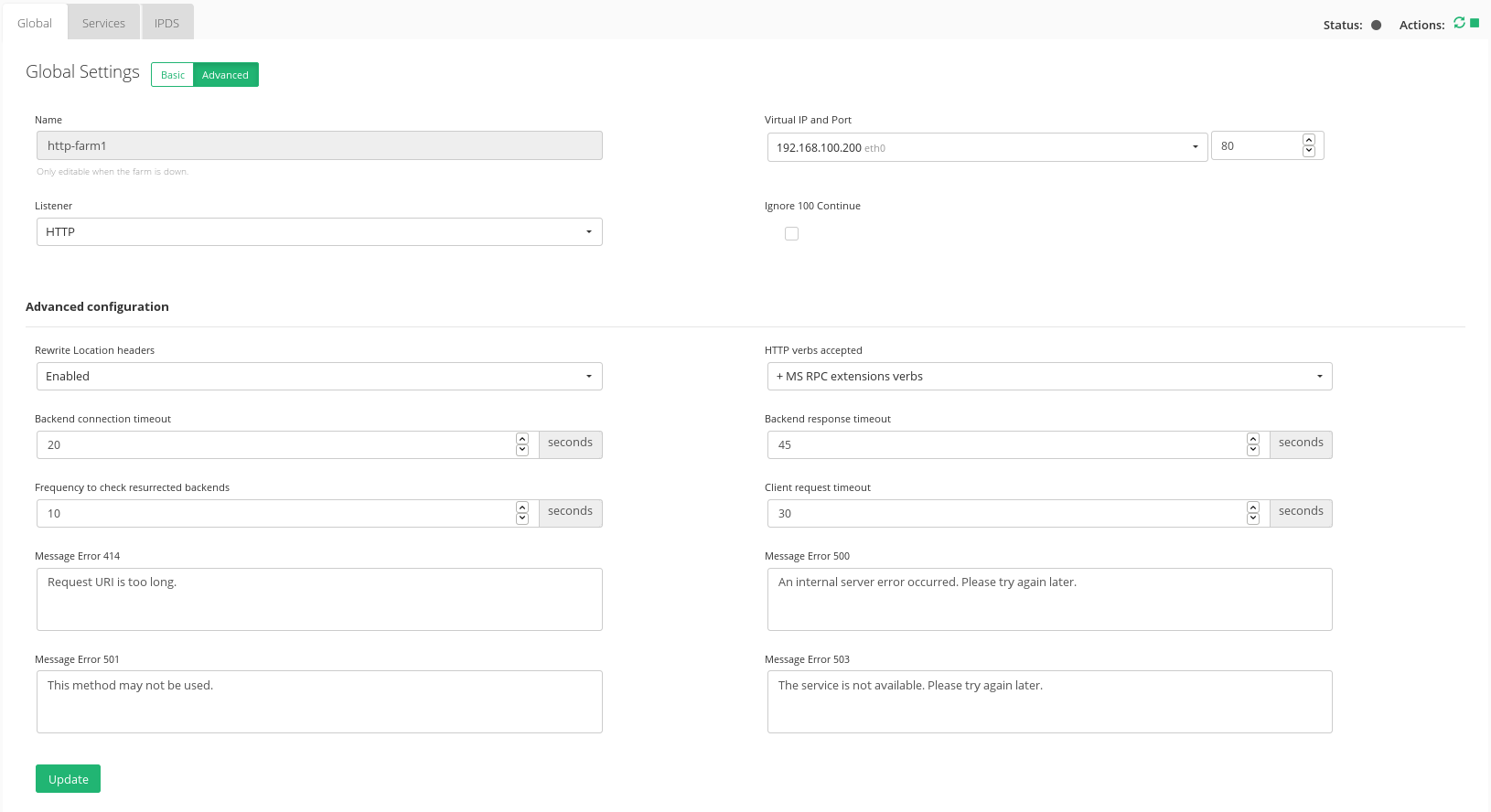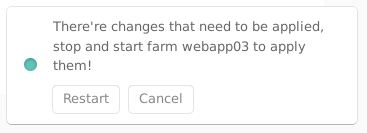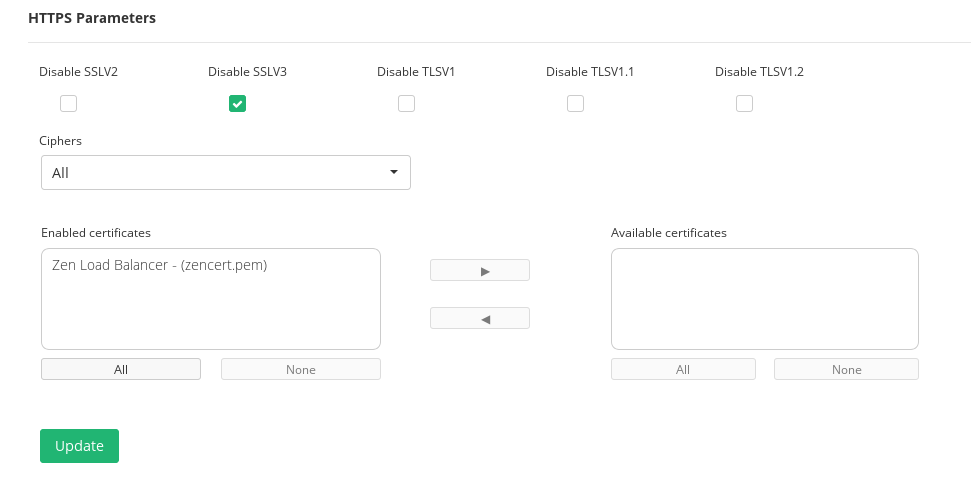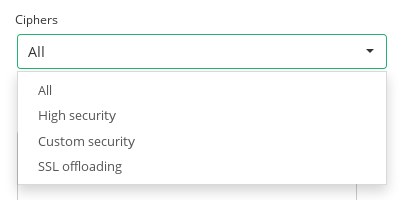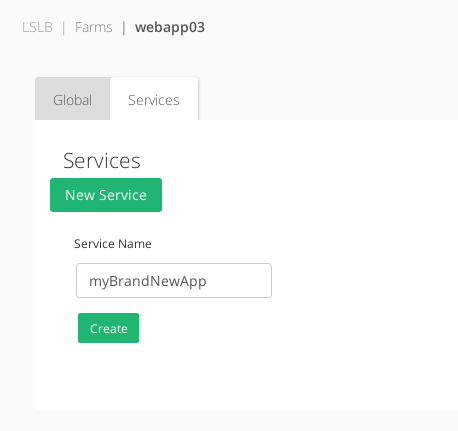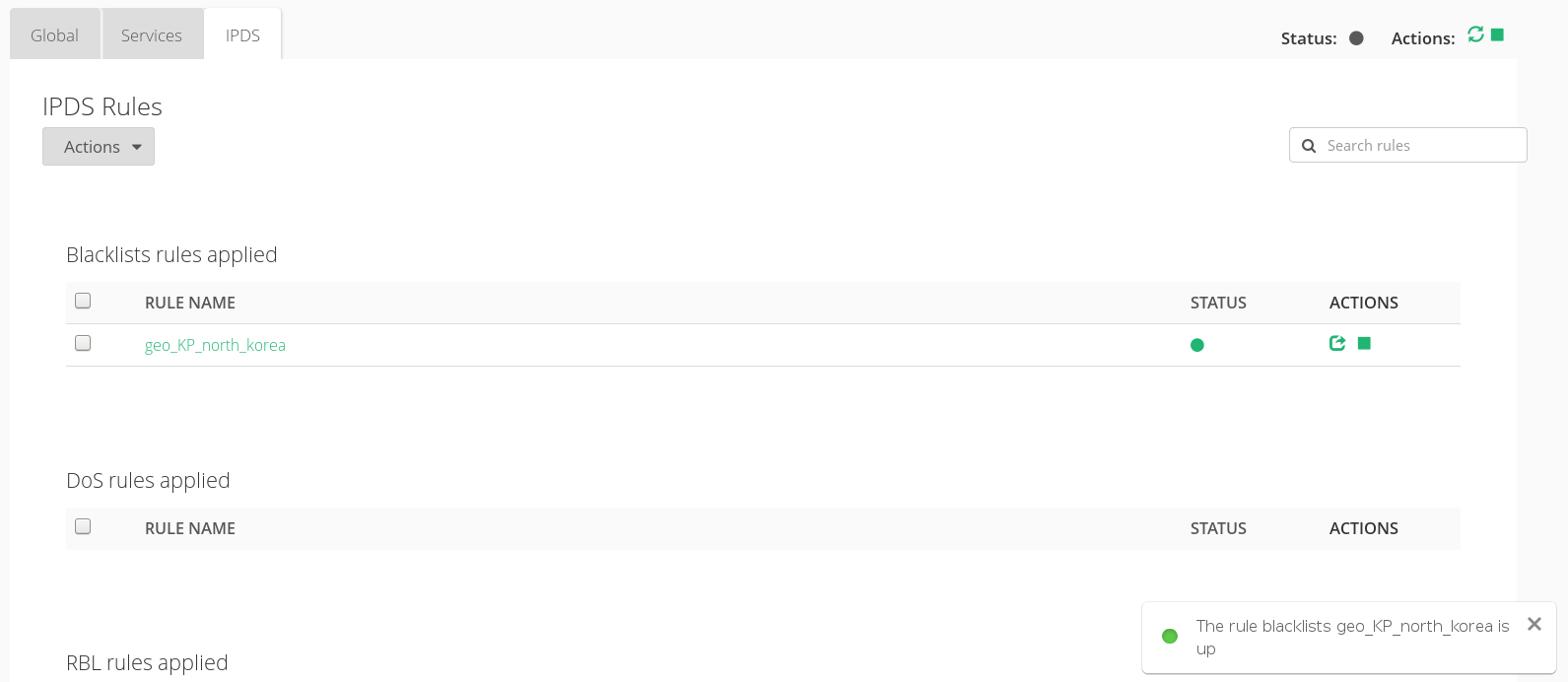Global Settings for HTTP Farm Profile
This profile manages content switching at HTTP layer 7 application delivery for both HTTP and HTTPS protocols.
When modifying any parameter in a HTTP/S farm through the Update green button at the bottom, it would be needed a manual restart in order to apply the changes, so a message will be shown at the left bottom of the page to alert the sysadmin that there are global parameters or backend changes that needs to be applied via a farm restart. The system administrator is able to modify whatever parameters are needed and then restart the farm service to apply all of them at the same time and when the time is more suitable.
After applying all these changes, please click on the Restart button and a message of success will be shown if the restart has been successfully done.
It also can be done manually using the Actions if needed. Notice the Upper Right Corner buttons added for that purpose:
The Status is shown by mean the color bullets as follow:
- Green: Means UP. Farm is running and all backends are UP.
- Red: Means DOWN. Farm is stoped.
- Orange: Means RESTART NEEDED. There are recent changes that need a farm restart to be applied.
- Black: Means CRITICAL. The farm is UP but there is not backend available or they are in maintenance mode
- Blue: Means PROBLEM. Farm is running but at least one backend is down.
- Yellow: Means MAINTENANCE. Farm is running but at least one backend is in maintenance mode.
Those color codes are the same all over the graphical user interface. You could see them better explained in the LSLB Farms Section
In the HTTP(S) farms profile, the HTTP header X-Forwarded-For is filled by default with the client IP address. By contrast with the L4xNAT farms profile, the HTTP profile use a weight algorithm implicitly.
Every HTTP(S) farm (or virtual service) is able to manage several web services through the same HTTP farm like a reverse proxy, therefore one HTTP virtual IP and port could handle more than one load balanced web service. For that reason, a service under a HTTP farm is a concept in order to offer the virtual host flexibility and then a list of backends will be shown for each service created.
The parameters for advanced HTTP/S farms profile are the following:
Name. It’s the identification field and a description for the farm service. In order to change this value you’ve to stop the farm in first place. Ensure that the new farm name isn’t already in use or an error message will appear.
Virtual IP and PORT. These are the virtual IP address and/or virtual PORT in which the farm profile will be binded and listening in the load balancer system. To make changes in these fields, ensure that the new virtual IP and virtual PORT are not in use. In order to apply the changes the farm service will be restarted automatically.
Listener. This field specifies the protocol to be managed at layer 7 for content switching.
- HTTP. The virtual service will only understand plain HTTP content.
- HTTPS. The virtual service will understand secure HTTP content, it’ll manage SSL handshake, it’ll handle secure ciphers configurations, SSL certificates (wildcard or SNI), etc, in order to perform SSL offload and unload the real application servers of these heavy tasks.
Ignore 100 Continue. If checked, the 100 Continue property will be disabled. According to the HTTP 1.1 protocol, when this header is sent, the form data is not sent with the initial request. Instead, this header is sent to the web server backend which responds with 100 (Continue). This means that the server has received the request headers, and that the client should proceed to send the request body (in the case of a request for which a body needs to be sent; for example, a POST request). If the request body is large, sending it to a server when a request has already been rejected based upon inappropriate headers is inefficient. To have a server check if the request could be accepted based on the request’s headers alone, a client must send Expect: 100-continue as a header in its initial request and check if a 100 Continue status code is received in response before continuing (or receive 417 Expectation Failed and not continue).
Rewrite Location headers. If enabled, the farm is forced to modify the Location and Content-location headers in responses to the clients. If they point to the backend itself or to the VIP (but with a different protocol) the response will be modified to show the virtual host in the request. If the option enabled and compare backends is selected then only the backend IP address is compared, this could be useful for redirecting a request to an HTTPS listener on the same server as the HTTP listener.
HTTP verbs accepted. This field indicates the operations that will be permitted to the HTTP client requests. If a not allowed verb is requested an error will be shown to the client. The verbs level are inclusive, so every level includes it’s verbs and additionally the lower level ones.
- Standard HTTP request. Accept only standard HTTP requests (GET, POST, HEAD).
- + extended HTTP request. Additionally allow extended HTTP requests (PUT, DELETE).
- + standard WebDAV verbs. Additionally allow standard WebDAV verbs (LOCK, UNLOCK, PROPFIND, PROPPATCH, SEARCH, MKCOL, MOVE, COPY, OPTIONS, TRACE, MKACTIVITY, CHECKOUT, MERGE, REPORT).
- + MS extensions WebDAV verbs. Additionally allow MS extensions WebDAV verbs (SUBSCRIBE, UNSUBSCRIBE, NOTIFY, BPROPFIND, BPROPPATCH, POLL, BMOVE, BCOPY, BDELETE, CONNECT).
- + MS RPC extensions verbs. Additionally allow MS RPC extensions verbs (RPC_IN_DATA, RPC_OUT_DATA).
Backend connection timeout. This value indicates how long the farm is going to wait for a connection to the backend in seconds. Usually, it will be the socket opening time wait. By default, this value will be set to 20 seconds.
Backend response timeout. This value indicates how long the farm is going to wait for a response from the backends in seconds. By default, this value will be set to 45 seconds.
Frequency to check resurrected backends. This value in seconds is the period to get out a blacklisted real server and checks if is alive. The farm will be checking the backend periodically once the real server is marked as down, regardless of whether there is a new client connection or not. By default, this value will be set to 10 seconds.
Client request timeout. This value indicates how long the farm is going to wait for a client request in seconds. Once this timeout is reached without getting any data from the client, the connection will be closed. By default, this value will be set to 30 seconds.
Personalized error messages. Through the personalized error messages, the farm service is able to answer a custom message of your site when a web code error is detected from the real servers. A personalized HTML page will be shown.
On the other hand, some HTTPS Parameters can be found below.
The Disable SSLV2, Disable SSLV3, Disable TLSV1, Disable TLSV1.1, Disable TLSV1.2 selectable buttons, if selected, avoid using those given protocols. Thus, once a protocol is disabled, it’s ciphers will also be disabled.
Ciphers. This field is used to build a list of ciphers accepted by SSL connections in order to harden those connection. Before a client and server can begin to exchange information protected by TLS, they must securely exchange or agree upon an encryption key and a cipher to use when encrypting data. Further information about security can be found on external resources such as Wikipedia.
In order to make use of ciphers please select one of the following options.
All. This item indicates that all ciphers are allowed to be managed by the HTTPS listener. This is the default setting.
High security. This option set by default the ciphers:
kEECDH+ECDSA+AES128:kEECDH+ECDSA+AES256:kEECDH+AES128:kEECDH+AES256:kEDH+AES128:kEDH+AES256:DES-CBC3-SHA:+SHA:!aNULL:!eNULL:!LOW:!kECDH:!DSS:!MD5:!EXP:!PSK:!SRP:!CAMELLIA:!SEED
Which they’ll be enough to pass through an A+ in ssllabs .
Custom security. This option allows to set your own allowed ciphers through the Customize your ciphers field..
Customize your ciphers. This is the allowed customized list of ciphers that will be accepted by the SSL connection, which it’s a string in the same format as in OpenSSL ciphers . This option will be displayed if Custom security is set.
SSL Offloading. Note that Enterprise Edition v5.1 includes new SSL Offloading capabilities which increases performance on CPUs AES compatible. If your hardware implements this capabilities this option will be shown. Other wise not.
Enabled certificates. The SSL certificates in this list will be the certificates that the farm will be able to manage.
Available certificates. These are the available SSL certificates installed in the device. To enable one of them you could either select the certificate and press de arrow button or you could simple drag and drop it from the Availble box to the Enabled box.
Services for HTTP Farm Profile
The services within a LSLB farm with HTTP profile provides content switching capabilities for web virtual services to deliver multiple web services and applications through the same virtual IP and PORT, which helps to unify web applications through one single domain, manage virtual hosts, manage URLs, configure redirects, configure persistence and backends per service. Every service within a LSLB farm could have different properties, health checks or backend list, and some regular expressions can be used as match conditions that can specify which service should be used per request.
Every service match condition will be checked by the HTTP farm profile core in priority mode (that can be altered if needed) and if none service is matched then the farm core will return an error. For this reason, specific multiple service definitions are allowed. If no URL is defined then every request will match. The HTTP service conditions will be determined by a virtual host and/or an URL pattern.
Firstly, it’s required to create at least one service in order to add backends.
After the creation, it’ll be asked to Restart the farm in order to apply the new service.
Once the new service is applied, the HTTP farm profile will parse every service conditions in order to match the correspondent service for each client request. Those services conditions could be determined by URL patterns, specific headers or redirection and allows to identify several web services in through the same farm.
The service conditions and options for HTTP farms profile are shown below.
Virtual Host. This field specifies the condition determined by the domain name through the same virtual IP and port defined by a HTTP farm. In order to discard this condition just leave it empty. This field supports regular expressions in PCRE format.
Url pattern. This field allows to determine a web service regarding the URL the client is requesting through a specific URL pattern which will be syntactically checked. In order to discard this condition just leave it empty. This field supports regular expressions in PCRE format.
The Virtual Host and URL pattern fields are used by Zevenet in order to take decisions at the time of match to a certain service, so if any value is configured in these fields the request will try to match it, if it doesn’t match the request will try to match to the next service. It’s recommended to include a last service as the default one if no match has been produced.
Redirect Value. This field behaves as a special backend, as the client request is answered automatically by a redirect to a new URL. If you configure a redirect value then DON’T configure backends in this service. If Virtual Host and URL pattern match then Zevenet sends an HTTP Location Header response to the client in order to be redirected to the configured URL.
Redirect Type. There are two options: Default or Append. With Default option, the URL is taken as an absolute host and path to redirect to. With Append option, the original request path will be appended to the host and path you specified.
Least Response. This checkbox enables an improvement of round robin algorithm. Dynamically, the load balancer establishes the connection with the lower value of response time.
HTTPS Backends. This checkbox indicates to the farm that the backends servers defined in the current service are using the HTTPS protocol and then the data will be encrypted before to be sent.
Persistence. This parameter defines how the HTTP service is going to manage the client session and which HTTP connection field has to be controlled to maintain safe client sessions. When a type of persistence session is selected a persistence session TTL will be shown.
- No persistence. The farm service won’t control the client sessions and the HTTP or HTTPS requests will be free delivered to real servers.
- IP: Client address. The client IP address will be used to keep open the client sessions through the real servers.
- BASIC: Basic authentication. The HTTP basic authentication header will be used to control the client sessions. For example, when a web page requests a basic authentication to the client a HTTP header will contain a string like the following:
HTTP/1.1 401 Authorization Required Server: HTTPd/1.0 Date: Sat, 27 Nov 2011 10:18:15 GMT WWW-Authenticate: Basic realm="Secure Area" Content-Type: text/html Content-Length: 31
Then the client answer with the header:
GET /private/index.html HTTP/1.1 Host: localhost Authorization: Basic QWxhZGRpbjpvcGVuIHNlc2FtZQ==
This basic authentication string is used like an ID for the session to identify the client session.
- URL: A request parameter. When the session ID is sent through a GET parameter with the URL will be possible to use this option indicating the parameter name associated with the client session ID. For example, a client request like http://www.example.com/index.php?sid=3a5ebc944f41daa6f849f730f1 should be configured the parameter Persistence Session Identifier:

- PARM: an URI parameter. Another way to identify a client session is through an URI parameter separated from a semicolon character that is used as a user session identifier. In the example http://www.example.com/private.php;EFD4Y7 the parameter will be used as the session identifier.
- COOKIE: a certain cookie. Also, you’ll be able to select an HTTP cookie variable to maintain the client session through the COOKIE option. A cookie has to be created by the real app programmer into the webpage to identify the client session, for example:
GET /spec.html HTTP/1.1 Host: www.example.org Cookie: sessionidexample=75HRSd4356SDBfrte - HEADER: a certain request header. An HTTP header custom field could be used to identify the client session. For example:
GET /index.html HTTP/1.1 Host: www.example.org X-sess: 75HRSd4356SDBfrte
Persistence Session Time To Live. This value indicates the max time of life for an inactive client session (max session age) in seconds.
Persistence Session Identifier. This field is the URL parameter, cookie or header field name that will be analyzed by the farm service and will manage the client session.
Cookie insert. If defined, Zevenet HTTP farms profile will inject a cookie in each response with the appropriate key of the backend, so that even if the session table is flushed or sessions are disabled, the proper backend will be chosen. This feature avoids to change the real server code to create a session cookie.
The Cookie Name is the name of the cookie that will be created from client to backend. The Cookie Path is the URI or relative path where the new cookie will be created, for the whole domain the character / needs to be set. Cookie Domain is the domain where the cookie is going to be created. Finally, Cookie Time to live is the number of seconds the cookie will be persisted in memory between the client and backend. If this value is set to 0, the cookie will expire when the browser closes.
After the service configuration, it’ll be required to update the changes through the green button Update.
In regards to the Backends section, the HTTP farm profile allows to configure the following real servers properties:
ID. It’s the index that references the backend in the farm configuration.
IP. The IP address of the given backend.
PORT. It’s the port value for the current real server.
TIMEOUT. It’s the specific value of timeout for a backend to respond. This value overrides the global Backend connection timeout farm parameter for the current backend.
WEIGHT. It’s the weight value for the current real server. More weight value indicates more connections delivered to the current backend. By default a weight value of 1 will be set. The values range available are from 1 to 9.
ACTION. The available actions per backend are:
- Add Backend. Add a new real server into the farm.
- Save. Save the new real server entry in the given farm and start using it.
- Cancel. Cancel the new real server entry.
- Enable Maintenance. Put a certain real server in maintenance mode, so no new connections will be redirected to it. There is two different methods to enable the maintenance mode:
- Drain Mode. Keeps established connections and persistence if enabled, but will not admit new conections.
- Cut Mode. Directly drops all active connections against the backend
- Start. Enable new connections to the real server again after the enabled maintenance.
- Delete. Delete the given real server of the virtual service.
- Edit. Modify a certain value of the real server.
IPDS
This section let you enable IPDS rules. The list shows different types of protection and a select box to enable them. For further information please go to the IPDS Black List, IPDS DoS or IPDS RBL specific documentation.
Action button permits to Add a new Rule as shown in next image. It also allows to “Unset”, “Enable” or “Disable” a given rule. When you unset a rule is removed from the rules list associated to the farm. The enable or disable actions makes the rule up and running or stop it respectively.
Once you add a new IPDS Rule you should select from the list the rule you would like to apply. Please have a look to next picture:
After selecting the rule to be applied you will see a screen like next one. There it will appear your new rule asociated to your farm. Initially the Status of the rule is “Down”. In order to activate the rule you need to press the green “play” triangle under Actions column. It will prompt a message announcing the rule is activated.
Check out our video to know how easy is to configure a HTTPS redirection with Zevenet.
Next step, use Farm Guardian for advanced health checks configuration.
